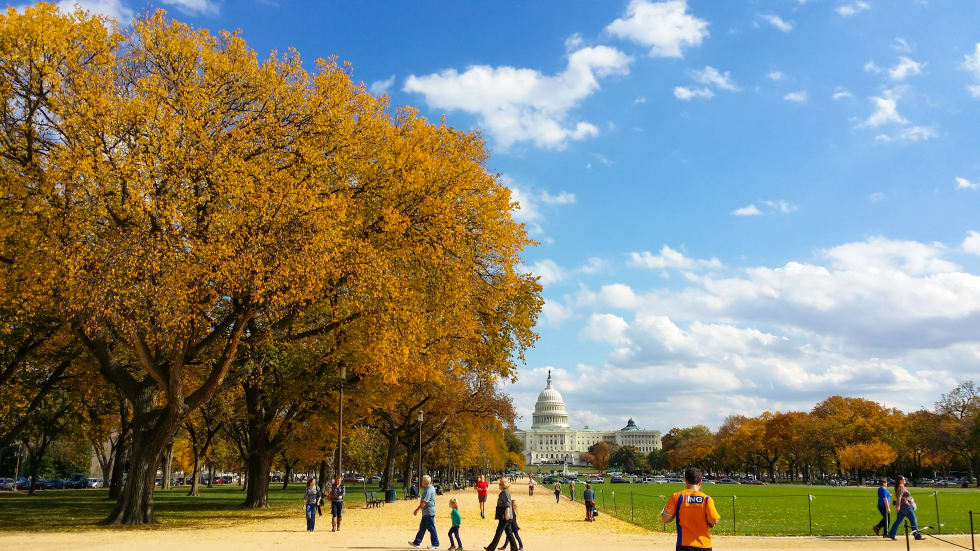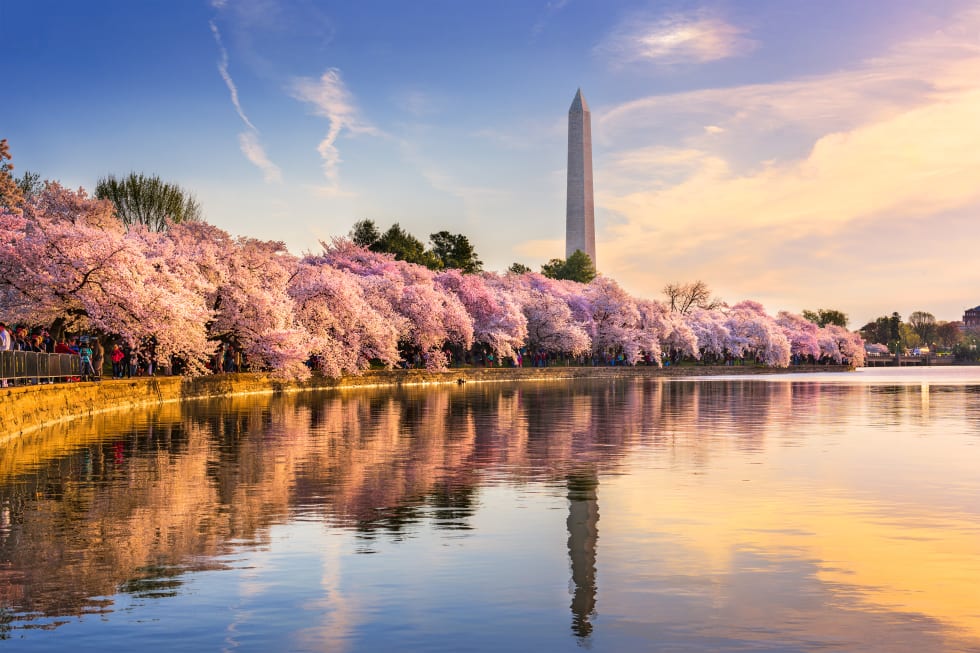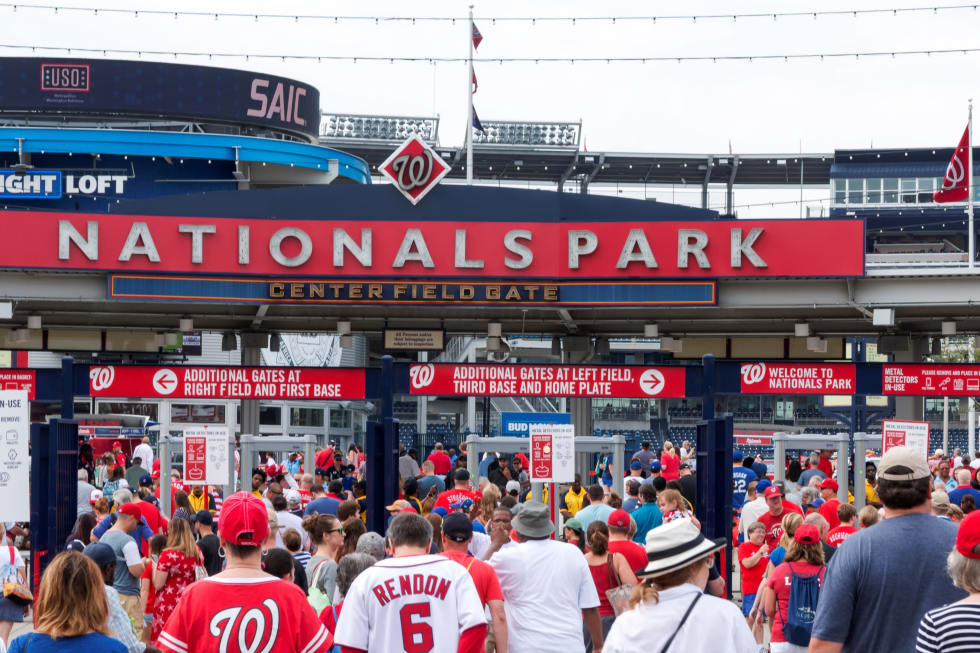The Wren D.C.
- 42 units available
- Studio • 1 bed • 2 bed
- Amenities
In unit laundry, Nest technology, Patio / balcony, Granite counters, Hardwood floors, Dishwasher + more

Washington, D.C. is a major metropolitan area in the US. Like most major cities, the Capital City boasts many amenities and attractions that keep residents and tourists enamored.
From the grand historical monuments to the lively city center, D.C. is in a unique position, serving as both our nation's government seat and as a bustling metropolis. Lovely parks, the Smithsonian Museums, and historic buildings are just some of the distinct attributes that make D.C. special.
If you are considering a move to the District of Columbia, you should work on your budget. It's essential to understand the cost of living before moving to Washington, D.C. Not only will this set you up for a comfortable living, but it’ll also ensure that you can find the perfect affordable apartment in a neighborhood that suits you.
Here's everything you need to know about the cost of living in Washington, D.C.
As to be expected with any major metropolitan area, living in Washington, D.C. can get pricey. We took a look at the data and found the average cost of living in Washington, D.C. is 51.9% higher than the national average. Here's how that figure breaks down:
| Category | Washington, D.C. | U.S. Average |
|---|---|---|
| Overall | 151.2 | 100 |
| Grocery | 114.1 | 100 |
| Health | 95.1 | 100 |
| Housing | 231.5 | 100 |
| Median Home Cost | $638,400 | $338,100 |
| Utilities | $106 | 100 |
| Transportation | 135.3 | 100 |
| Miscellaneous | 175.9 | 100 |
Washington, D.C. is already expensive, but one of the most expensive neighborhood in the area is Woodley Park. According to our data from September 2025, the rents in Woodley Park range from $3,749 to $6,107, with an average rent of $4,965. The overall median rent in all of Washington, D.C. is $2,210 a month.
The cheapest neighborhood in Washington, D.C. is Anocostia. According to our data from September 2025, the rent ranges from $1,368 to $1,942 with an average rent of $1,957. For context, the median rent in all of Washington, D.C. is $2,210 a month.
As of September 2025, the median rent in Washington, D.C. is $2,210, making it #14 among the 100 largest U.S. cities. Month-over-month, rents are essentially flat, with a slight dip of 0.1% in August. On a yearly basis, rent has decreased by 1.2%, which is comparable to the national downward trend of −0.9% year-over-year.
Nationwide, the median rent is $1,400, down 0.9% year-over-year.
Within the D.C. metro area, the city’s median is about 0.6% higher than the broader metro average, which is $2,198, suggesting that city rents are closely aligned with regional patterns.
Overall, Washington, D.C. is among the most expensive rental markets nationally. It’s outranked by New York and San Francisco, but still has premium rent levels well above the national median. Within its own metro area, Washington, D.C., remains slightly pricier than surrounding suburbs, but not dramatically so, indicating a relatively uniform pressure on rental prices across the Washington, D.C. region.
| Bedroom Type | Median Price |
|---|---|
| Overall | $2,210 |
| One Bedroom | $2,185 |
| Two Bedroom | $2,243 |
We looked at the data from September 2025 to give you an idea of the overall average rent in Washington, D.C. The overall median rent in the city stands at $2,210, above the national average of $1,401. The median rent in Washington, D.C., fell by 0.1% in August and decreased by 1.2% over the last year.
Washington D.C:
| Bedroom Type | Median Price |
|---|---|
| Overall | $2,200 |
| One Bedroom | $2,652 |
| Two Bedrooms | $3,873 |
Washington, D.C. rent costs have fallen 1.1% last month to show some relief in the market. The current median rent for a one-bedroom apartment in D.C. is $2,652, but varies by neighborhood.
| Area | Median Rent |
|---|---|
| Overall | $2,652 |
| 16th Street Heights | $1,915 |
| U-Street | $2,662 |
| Foggy Bottom | $3,151 |
If you need more space or are teaming up with a roommate, you'll spend a median rent of $3,873 on a two-bedroom apartment in Washington, DC. You can save even more by looking to move to suburbs outside of the city. D.C. prices can fluctuate based on location and amenities.
| Area | Median Rent |
|---|---|
| Overall | $3,873 |
| 16th Street Heights | $2,470 |
| U-Street | $3,999 |
| Foggy Bottom | $4,940 |
Washington, D.C. rent prices are higher than the average and have comparable rents to New York and Miami. The housing market has also seen steady growth year-over-year. The median home price in Washington, D.C. is currently at $638,400, while the national average is $338,100.

To figure out how much you should budget for rent, we recommend the 30% rule. The gold standard for budgeting is that your housing cost, such as rent or mortgage payments, shouldn’t exceed 30% of your monthly income before taxes. In Washington, D.C, if the rent for a one-bedroom apartment is $2,162, a D.C. resident should make around $86,840 annually before taxes. This is $7,236.67 a month or $45.22 an hour. In a city like D.C., rental prices can swing widely by neighborhood. But this rule can serve as a helpful starting point.
Of course, choosing to split rent with a roommate or two can dramatically cut the cost of D.C.'s pricey rents and reduce your share of utilities and common expenses.
According to MIT’s Living Wage Calculator, a single adult with no kids in Washington, D.C., needs to earn around $25.98/hour—roughly $54,034 annually—to cover basic expenses without financial strain. If you have dependents or higher monthly costs, that number increases accordingly. To comfortably afford Washington’s median rent of $2,188, you’d need to earn roughly $86,840 per year.
D.C. residents can expect to pay $6,106 for a single adult each year on transportation. For a family of two working adults and two children, that figure climbs to $10,242.
The Washington Metropolitan Area Transit Authority handles Washington, D.C.'s public transportation. Your fare will depend on several factors, including the time of day for your trip and the distance between stations. You can use the Metro's trip planner feature to calculate your fare.
Residents can use the eco-friendly SmarTrip Card for passage on Metrorail and buses throughout the Metro area. It's best to load these cards and keep track of your credit via the mobile app.
That said, D.C. is a walking and biking city, even though many residents own vehicles.
In D.C., food will be a significant part of your budget. A single resident in Washington, D.C. spends $5,409 a year on food. However, if you’re moving your family, including your spouse and two children, expect to pay $15,854 a year. These rates are based on assumptions that the family doesn’t eat out regularly or splurge on lots of extras.
With all the delicious, global restaurants in the D.C. Metro area, you may end up dining out quite a bit. According to Numbeo, eating for one in D.C. costs an average of $25 at an inexpensive restaurant, not including a tip, at an inexpensive restaurant. A mid-range restaurant with a three-course meal for two could cost $120 and up.
In D.C., child-care costs average roughly $25,693 a year for one child, and $48,072 for two children.
Because these costs are so steep, many parents get creative to reduce them. Some possibilities include job‐sharing, co-ops, or nanny sharing with other families, which can reduce costs. In addition, remote work or flexible schedules might allow for lower-cost care or reduce total hours needed in full‐time daycare.
For some, moving slightly outside high-demand areas or selecting child care centers with fewer wait lists can result in significant savings.
It's important not to skimp on healthcare to stay ahead of issues. For healthcare and medical costs, a single adult will pay around $3,073 a year. For a family of four with two working adults and two children, the cost rises to $9.537.
However, your circumstances may vary depending on your lifestyle, age, and other factors. So, it's best to do your research and shop around before making a final decision about your health insurance costs.
Utility costs in Washington, D.C. average a total of $204.10 monthly. This includes your fuel, water, gas, and electricity bill costs. For Internet at 60 mbps or more, you'll pay an additional $70.01 a month, bringing your total to $274.11.
If you’re worried about utility costs, opt for a recently renovated apartment with energy-efficient appliances, or search for units that offer all utilities bundled in with the cost of the rent. Either of these options can help you save on utility costs.

While D.C. might not be known as the entertainment capital of the world, it does not lack in recreation, fun, and entertainment.
The average cost of a gym membership in Washington, D.C. is $103.76 for a single adult. However, if you prefer tennis, you can rent a court for an hour for just $38.41.
Various parks within the D.C. area offer an opportunity for fitness and free fun. Rock Creek Park even boasts a Planetarium to make the night sky visible for all to see. Hiking, biking, walking, running, and more: there's so much to do.
If you prefer to head indoors for your fun, the Smithsonian offers free general admission. You can peruse various exhibits without spending a dime. It's the perfect way to spend an afternoon, or several, as the museum is massive.
The Capital One Arena, located in the Penn Quarter - Chinatown neighborhood of D.C., is the D.C. sports circuit's heart and soul.
Whether you want to catch an NBA, WNBA, NHL, or collegiate basketball game, you can head to the arena.
If you're a baseball fan, you can watch the Washington Nationals play at Nationals Park in the Navy Yard, one of the best neighborhoods in D.C.

Residents in D.C. have to pay the federal income tax, despite not being given full statehood and having a non-voting Congress representative. Additionally, residents pay a District Income Tax, sales tax, and property taxes.
Washington, D.C.’s job market has been facing some challenges, with the unemployment rate reaching 6.0% in July 2025, the highest in the nation. While there were about 34,000 job openings this spring, federal spending cuts and workforce downsizing have slowed growth in a city where government jobs and contracts drive much of the economy. These shifts create ripple effects across related industries, from contractors to real estate.
Don’t waste weeks scrolling or settle for a place that doesn’t fit your needs. The various neighborhoods in Washington, D.C., have something for every budget and lifestyle.
Ready to find a new apartment? Take Apartment List’s personalized quiz to get matched with apartments that fit your needs, must-haves, and move-in timeline. With us, you’ll spend five minutes and save 50 hours searching.
As of September 2025, the average rent in Washington, D.C., for a 1-bedroom apartment is $2,652. The average rent for a 2-bedroom apartment in Washington, D.C., is $3,873.
The cheapest neighborhood in Washington, D.C, is Anacostia. According to our data from September 2025, the rent ranges from $1,368 to $1942 with an average rent of $1,957. The median rent in all of Washington, D.C. is $2,210 a month.
As of September 2025, the median rent in Washington, D.C. is $2,210. That varies depending on the neighborhood you live in.
In addition to rent costs, D.C. residents can expect to pay $6,106 for a single adult each year on transportation. A single adult will pay around $3,073 a year for healthcare, and $5,409 for food.
The population in Washington, D.C. is 689,545.
According to the U.S. Census Bureau, the median household income in Washington, D.C. is $109,707, or about $52.74 an hour. The gold standard for budgeting is that your housing cost shouldn’t exceed 30% of your monthly income before taxes. In Washington, D.C, if the rent for a one-bedroom apartment is $2,162, a D.C. resident should make around $86,840 annually before taxes. This is $7,236.67 a month or $45.22 an hour.




In unit laundry, Nest technology, Patio / balcony, Granite counters, Hardwood floors, Dishwasher + more
In unit laundry, Patio / balcony, Granite counters, Hardwood floors, Dishwasher, Pet friendly + more